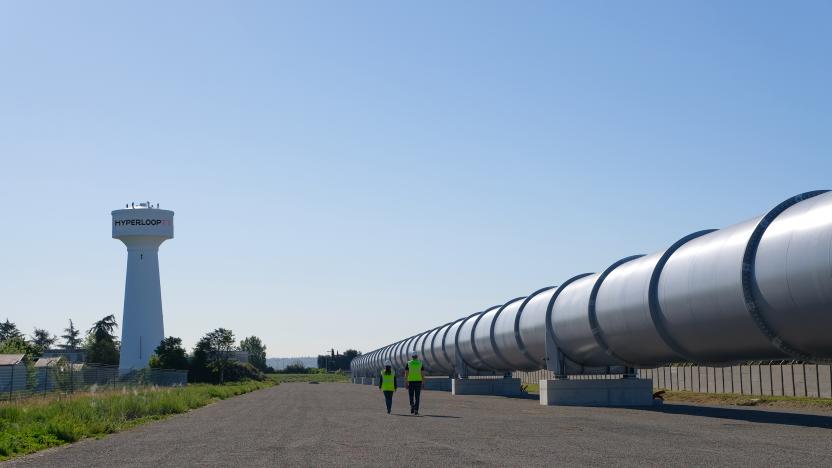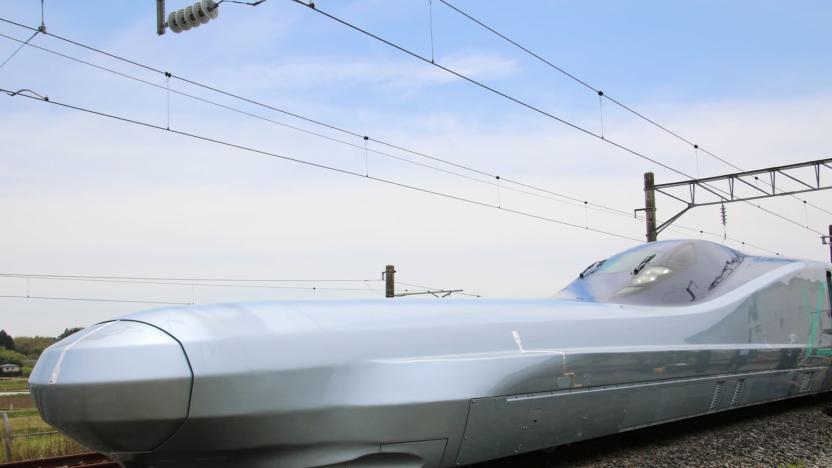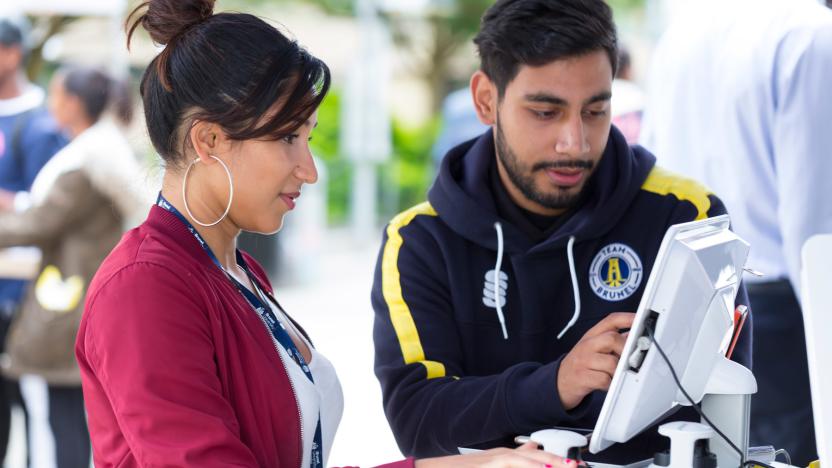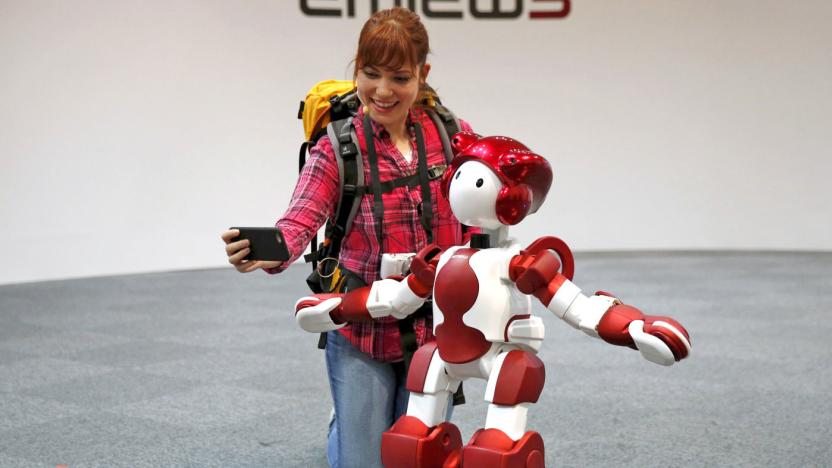Hitachi
Latest

In the face of COVID-19, one hyperloop company is making friends
The company has announced major partnerships with Capgemini, Ferrovial and Hitachi, big names in the world of legacy rail and infrastructure.

Japan begins testing the world's fastest bullet train
Last week, Japan started testing its latest and fastest bullet train. The Shinkansen ALFA-X is capable of reaching 400 kilometers per hour (249 mph), and it's expected to enter operation around 2030. When it does, the ALFA-X will likely become the world's fastest bullet train, carrying passengers around 360 kph (224 mph).

Japan Display built a 1,001-ppi screen for VR headsets
Japan Display (JDI) has unveiled plans for high resolution LCD screens that could substantially improve the displays found in current VR headsets. JDI -- a joint enterprise made up of Sony, Toshiba and Hitachi -- says it's developing a 3.25-inch 1,001 ppi (pixels per inch) LCD, which will also purportedly feature lower latency and energy consumption levels. According to JDI, these are the key ingredients required to unlock natural-looking video on higher resolution displays.

London Costcutter trials finger-vein readers for faster payments
The humble Costcutter supermarket at Brunel University in London has recently become home to a biometric payment system that allows customers to check out with a tap of their finger. The store's owner has begun trialling Sthaler's Fingopay system, which authenticates people by looking at the 3D pattern of veins beneath their fingertip -- one of the most unique identifiers around -- rather than their fingerprint.

Adorable robots help travellers at Tokyo's Haneda airport
Getting lost in an international airport is never fun -- but if you're lost in Japan's Haneda this month, you'll at least be able get help from an adorable talking robot. From now until the 14th, Hitachi is testing its EMIEW3 humanoid robot in the airport's passenger terminal. Over the course of two weeks, EMIEW3 will direct visitors to an information display and answer questions in both English and Japanese.

Six futuristic data storage technologies
By Cat DiStasio Digital technology is taking over the world, and scientists are hard at work finding better ways to store data -- lots of it and for long periods of time. Scientists are exploring new materials for data storage as well as new methods for printing data on their chosen medium. While some companies are storing data on the ocean floor, other imagineers look upward, dreaming of giant storage skyscrapers. With so many different innovations happening in such a short period of time, the race is on to unlock the keys to near-limitless data storage potential.

Hitachi is rolling out a series of Roku TVs this fall
Roku TVs are a growing trend, with several manufacturers jumping on the bandwagon to bring the streaming service to their own televisions. Hitachi is the latest to join the club, planning on releasing both 1080p and 4K TVs in a "variety of screen sizes" starting this fall.

Hitachi's answer to Pepper the robot is swifter and sturdier
Look out, Pepper: you have some fresh competition. Hitachi has unveiled EMIEW3, its first humanoid assistant robot built for full-fledged commercial service. Like its SoftBank-made counterpart, it's designed to help you find your way around stores and public facilities. It's particularly focused on tourists, as it can switch languages on the fly. However, its edge may simply be its ability to cope with real-world situations. It's much faster than Pepper (3.7MPH versus 1.2MPH), so it's more likely to keep up with humans; it can also get back up if it falls down, and listen to you in noisy street environments.

Barclays wants you to give it the finger instead of a PIN
PINs, passwords and authentication codes: they're a troublesome security solution that we'd love to see the back of. The bankers at Barclays know this, so they've looked to biometrics in a bid to banish them forever. Today, the company announced that it's teaming up with Hitachi to launch a new reader capable of scanning and recognising the unique vein patterns a customer's hand. It'll let you scan your finger to quickly access your online bank accounts and authorise payments, reducing fraud in the process. Hitachi's Finger Vein Authentication Technology does the hard work and is said to be significantly harder to spoof because it'll only work if the scanned finger is "attached to a live human body" (no finger-lopping movie plotlines happening here). Barclays' Biometric Reader will roll out first to business account holders from next year, but staff at UK branches may ask you to put your best finger forward in the very near future.

Researchers developing reactor powered by nuclear waste
Nuclear energy could have curbed C02 emissions long ago if not for one problem: the waste is toxic for over 100,000 years. That's quite a commitment for humanity, but Hitachi thinks it has the answer: burn the spent fuel in small reactors to generate more power. That would produce manageable waste that would be harmless in a mere century or so. Hitachi has been studying such reactors for awhile with GE, and has enlisted MIT, the University of Michigan (U-M) and University of California, Berkeley (UCB) for the next phase. The goal is to re-purpose existing boiling water reactors (RBWRs), so that their turbines, safety systems and other components could be reused. Researchers could then focus on the core tech needed to burn highly refined "transuranium elements," aka spent nuclear fuel. They've enlisted the three schools to jointly analyze the safety and performance of potential core designs, with the aim of eventually building a test reactor. Commercialization is probably decades off, but the way toxic waste is building up, they may want to hustle it along.

The 46-year-old sex toy Hitachi won't talk about
1968. It was the year of the Tet Offensive; of Martin Luther King Jr.'s and Robert Kennedy's assassinations; of the Democratic National Convention riots. It was also the first time humans had photographed the Earth from deep space. It was a year of great innovation and devastation. American values were in upheaval and the sexual revolution was well underway, calling into question outmoded sexual stereotypes. In the midst of all of this, an unlikely star was born.

Hitachi is building the world's fastest elevator: 95 floors in 43 seconds
In 2016, Hitachi will take over Toshiba's title as the maker of the fastest elevator in the world. The Japanese company's slated to install two lifts that move at a swift 45mph inside China's Guangzhou CTF Finance Centre, currently under construction. Apparently, you can reach the 95th floor (the building will have 111 floors in all) straight from the ground in just 43 seconds on one of these zippy elevators -- hardly long enough to freshen up before reaching the office. Toshiba's current record-holding lifts in Taipei 101 (a skyscraper in Taiwan) ferry people up and down floors at only 38mph.

Japanese robot gets better at not running into people
Hitachi is taking Asimov's I Robot law about not harming humans more seriously with new tweaks to its wheeled Emiew 2 bot. The 30-pound humanoid now packs a sensor that'll measure walking speeds (in an office, for instance) and generate mapping data to predict where someone might pop up unexpectedly. It'll then avoid those areas or slow down so as not to roll into your kneecaps. Given Emiew's 31-inch frame and 4 mph speed, we weren't too worried anyway -- there are other, decidedly more terrifying robots to avoid.

Backblaze stats on 27,000 hard drives show which ones keep on ticking
When your business value proposition is delivering inexpensive, reliable cloud backup for thousands of customers, you're going to learn a thing or two about drive reliability. The Backblaze team has been sharing that HDD savvy (gleaned from several years' experience and more than 75 petabytes of storage) in a series of blog posts over the past couple of months, and we've been fascinated to note their discoveries. Now Brian Beach at Backblaze has addressed the eternal question: What hard drive should I buy? BB's StoragePods are packed with consumer-grade hard drives just like the ones you'd buy at Costco or Best Buy, so it's reasonable to use Backblaze's failure stats as a proxy for how these drives might perform on your very own desk with your very own Mac. Granted, drives in a StoragePod are in more continuous use and subject to more vibration than a home-use drive, so your mileage may vary. Of the 27,000-plus drives running in Backblaze's server racks, the vast majority (almost 13,000 each) are Seagate or Hitachi models. There are only a couple of drives that Backblaze won't buy or try -- WD's Green 3TB drives and Seagate LP (low power) 2TB models -- because the BB StoragePod environment doesn't agree with them, possibly due to vibration sensitivity on spin-down/spin-up. Other than that, the company buys drives on a commodity basis, going with the best GB/$ ratio available at a given point in time. Best of the BB batch? Hitachi/HGST's Deskstar 2 TB, 3 TB and 4 TB models. Beach says, "If the price were right, we would be buying nothing but Hitachi drives. They have been rock solid, and have had a remarkably low failure rate." At the moment, due to price fluctuations, the drives of choice are a Seagate HDD.15 4 TB unit and the Western Digital 3 TB Red. As Beach notes, however, Hitachi's storage unit (originally purchased from IBM in 2002) has been bought (and split) in the past two years, with the 3.5-inch business going to Toshiba and the 2.5-inch product line going to WD. Although HGST is still marketing and making the Deskstar line, it's likely that technology will settle under the Toshiba brand in the future.

Backblaze stats show most/least reliable hard drives: Hitachi leads the pack with lowest annual failure rate
Online backup firm Backblaze has a lot of consumer-grade hard disk drives spinning away in their open-source Backblaze Storage Pods -- 27,134 at the end of 2013, to be exact. Over the past several months they've been providing us with statistics generated by keeping an eye on all of those drives. First they told us how long a hard disk drive should last, followed by some info on whether or not those pricey enterprise-grade drives really last longer than cheap consumer-grade drives. Now they're back with a blog post on what company makes the most reliable hard drives. With the caveat that these are consumer-grade drives being used in a very high-vibration environment under stressful conditions, Backblaze's Brian Beach noted that they've excluded the Western Digital Green 3 TB and Seagate LP (low power) 2 TB drives. These drives tend to spin down when not in use and then spin right back up, which causes a lot of wear and tear and a high failure rate in the Backblaze environment. It's not that they're bad drives -- they're just not suited for the high-stress environment of a storage farm. As you can see in the graphic at the top of this post (taken from the Backblaze study), Hitachi drives tend to have the lowest annual failure rates for Backblaze, followed by Western Digital drives. Seagate drives have a much higher failure rate, although the larger 3 and 4 TB drives tend to be more reliable than the 1.5 TB model. Of the 1.5 TB Seagate drives, the Barracuda LP is the most reliable, but the Barracuda Green drives are -- to quote Beach -- "dropping like flies." Beach notes that "if the price were right, we would be buying nothing but Hitachi drives. They have been rock solid, and have had a remarkably low failure rate." I've always been a fan of Western Digital drives, so I was happy to see that they also tend to be survivors in the Backblaze world. You can see the relative survival rates for Hitachi, Western Digital and Seagate drives in the graphic at the bottom of this post. For a more detailed look, be sure to read Beach's blog post over on the Backblaze site.

Japan Display joins the Quad HD phone screen party with two new LCDs
LG clearly doesn't have a monopoly on Quad HD smartphone screens -- Japan Display has unveiled two low-temperature polysilicon (LTPS) LCDs that offer the extra-sharp 2,560 x 1,440 resolution. The headlining 5.4-inch panel is ever so slightly denser than its Korean equivalent, at 543ppi; there's also a 6.2-inch (473ppi) model for giant devices. Both LCDs have "dead-bands" that are just 1mm thick, which should lead to extra-slim bezels on finished products. Japan Display hasn't said which companies will use the Quad HD screens, but it's easy to see one of the joint venture's partners (Hitachi, Sony or Toshiba) calling first dibs.

Hitachi ROPITS transport robot takes you where you choose on your tablet (video)
Those who need assisted transport have few options for getting around city sidewalks beyond a wheelchair. Hitachi thinks its ROPITS (Robot for Personal Intelligent Transport System) could provide a slicker approach -- and make those of us on foot rather jealous, quite frankly. Steering the single-seater is just a matter of picking a destination on a smartphone or a tablet and letting the pathfinding system figure out the rest. The robot can even come to the owner, if that's too much of a trek. ROPITS won't be much of a risk to pedestrians at a 3.7MPH traveling speed, but it should be a good citizen with both a stereo camera and laser rangefinders to avoid collisions and gauge its position better than GPS alone. If Hitachi's ongoing testing proves the viability of the concept, we may never have to worry about how we'll get around the neighborhood. [Image credit: Nikkan Kogyo Shimbun, YouTube]

HGST outs Touro Mobile Pro external hard drive and Travelstar 2.5-inch HDD
Here at CES, HGST (Hitachi Storage) has announced two storage options that look to immediately get cozy in your workflow. First, the "industry's first" 1TB 7,200 RPM 2.5-inch Travelstar HDD measures 9.5mm and looks to boost performance over 5,400 RPM models for $100. If an external storage solution is more your style, the Touro Mobile Pro houses one of the aforementioned 1TB hard drives with USB 3.0 connectivity, two-level protection and 3GB of could storage. The Touro will set you back $109 and like the Travelstar, is available now. Need to check the fine print before committing? Consult the full announcement that follows after the break. Follow all the latest CES 2013 news at our event hub.

G-Technology updates G-Drive mini and G-Raid mini with 1TB HGST Travelstar hard drives
G-Technology's G-Drive mini and G-Raid mini have been around for a bit, but the storage brand is taking the opportunity at CES to update the duo with Hitachi's (HGST) Travelstar hard drives. Both external storage repositories are set to get the 1TB 7,200 RPM 2.5-inch components that notch the measuring tape 9.5mm. The G-Drive mini is now available for $200 sporting one of the drives, USB 3.0 and Firewire 800 connections. Dual-wielding the Travelstar, the G-Raid mini touts 2TB capacity while remaining Firewire bus powered during USB 3.0 transfers, RAID configurability and is scheduled to arrive in Q1 for $450. A few more details about each model awaits in the full PR below. Follow all the latest CES 2013 news at our event hub.

Hitachi intros UltraVision LED TVs with Roku-ready HDMI, freshens Value TVs and sound bars for the fall
Although Hitachi was one of the first in line to promise support for Roku Streaming Sticks through MHL, it didn't have much more to say without the TVs to back up the claim. The second half of the puzzle is complete now that the company's fall TV revision is underway. Snag its new UltraVision UltraThin S606 TV in its one of its 42-, 46- or 55-inch sizes and you can discreetly (if optionally) hide the equivalent of a full Roku box in one of the HDMI inputs. The S606 sits strictly in the mid-range, however. Its 120Hz, edge-LED LCD design is superceded by the W806, which comes only in 48- and 55-inch sizes while carrying 3D, IPTV support and WiFi. Those who can get by on 60Hz refresh rates can opt for the Value line, where the H306 and S406 offer 720p in 29- and 32-inch dimensions; a third H316 line brings 1080p to those same sizes while adding a 39-inch panel. Hitachi hasn't said whether stores are stocking the TVs today, but it sees pricing ranging from $329 in the smaller Value sets to $1,399 for the largest W806 variant. The TV builder's audio mix isn't being ignored with the refresh. Launching in tandem with the TVs, the HSB32B26 and HSB40B16 sound bars are designed to respectively match up with 32- and 40-inch TVs while delivering 3D sound processing and Apt-X Bluetooth audio. At $149 and $199, the sound bars are close enough in cost that we may only need a measuring tape to settle any purchasing dilemmas once the hardware is in stores.














